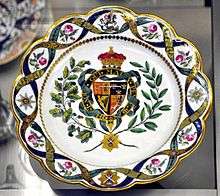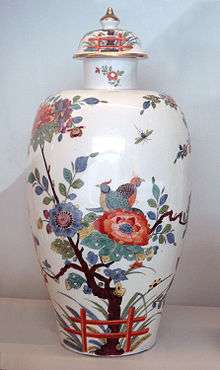Armorial ware


Armorial ware or heraldic china (and a variety of other terms) are ceramics decorated with a coat of arms. Armorials have been popular on European pottery from the Renaissance with examples seen on Spanish Hispano-Moresque ware, Italian maiolica, slipware, English and Dutch Delft, and on porcelain from the 18th century. Earlier examples were mostly large pieces for display, but later whole services, all painted with the arms, were produced.

The term is most often associated, with Chinese export porcelain, often decorated with the arms and crests of European and American families from the late 17th century through the 19th century.[1] British clients imported about 4000 services from 1695 until 1820, when a new prohibitive tax stopped the trade, as the British government sought to protect the domestic potteries.[2]
They were, and even more are, often only used at table on special occasions. They are popular with collectors.
See also
| Wikimedia Commons has media related to Armorial ware. |
References
- ↑ Nilsson, Jan-Erik. "Armorial porcelain". www.gotheborg.com/. Jan-Erik Nilsson. Retrieved 6 January 2015.
- ↑ Friar, Stephen, ed. (1987). A New Dictionary of Heraldry. London: Alphabooks/A&C Black. p. 103. ISBN 0 906670 44 6.

